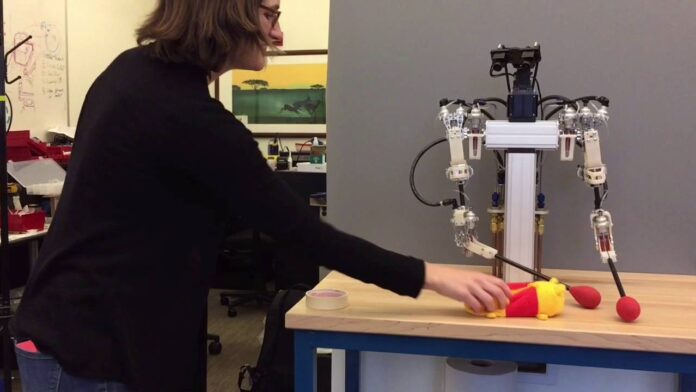Meet Jimmy—a robot puppet that moves with an almost lifelike grace, thanks to a pioneering fluid actuation system. Unlike traditional humanoid robots that often rely on bulky electric motors and gears, Jimmy uses an ingenious combination of air and water within tubes to create motion. This fluid-based design not only enables rapid and smooth movements but also allows the robot to interact safely with people. In one demonstration, Jimmy was seen engaging in playful activities like waving, dancing, drumming on a table, and even playing patty-cake with a child.
A New Kind of Actuator
The secret behind Jimmy’s performance lies in its unique actuator system. Rather than using standard motors, Disney researchers developed a device that employs two distinct fluid transmission lines: one filled with air and the other with water. The air-filled tube acts as a preloaded spring and damping mechanism, while the water-filled tube directly powers the joint movement. Inside each actuator, a rolling diaphragm moves back and forth within cylinders to push a rod. A simple gear mechanism then converts this linear motion into rotation. Weighing only 120 grams, each actuator can deliver up to 4.5 newton meters of continuous torque over a 135° range. The hybrid air-water setup improves both speed and torque, offering a higher torque density than many traditional motor-based systems, and its compliant, backdrivable nature makes it inherently safe for close human interaction.
Bridging the Gap Between Robotics and Human Interaction
One of the most captivating aspects of Jimmy is the emotional connection people feel when they encounter it. His movements are described as “very fluid,” capturing the imagination much like other Disney creations. The design also offers a practical advantage: by relocating heavy components like motors away from the robot’s limbs, the system enables the construction of lighter and more agile appendages. However, like all fluid-based systems, it does require regular pressure checks and occasional recalibration due to minor fluid loss over time.
The Role of the Puppeteer and Future Possibilities
Currently, a human operator controls Jimmy through a puppet-like setup. The operator uses a replica of the robot, which is connected to Jimmy via a series of air and water lines that faithfully transmit motion. This setup even allows the operator to feel haptic feedback—such as the sensation of contact when Jimmy touches something—thanks to a paired stereo camera and head-mounted display that relay real-time information. While this approach was initially designed to sidestep the challenges of perception and artificial intelligence, it also lays the groundwork for developing a fully autonomous version in the future.
Beyond Entertainment
The potential applications of this fluid actuator technology extend far beyond animatronics in theme parks. Researchers are exploring its use in fields like personal robotics, where delicate yet rapid manipulation is crucial, and even in medical settings—for example, in MRI-compatible systems for remote needle biopsies. The natural haptic qualities of the system offer significant benefits, both for human-operated and autonomous robotic systems, especially in environments where safe, precise contact is necessary.
In summary, Jimmy represents a remarkable fusion of elegant engineering and practical robotics design. By leveraging the unique properties of fluid dynamics, Disney researchers have created a system that not only performs with impressive speed and precision but also opens up exciting new possibilities for future robotic applications.





